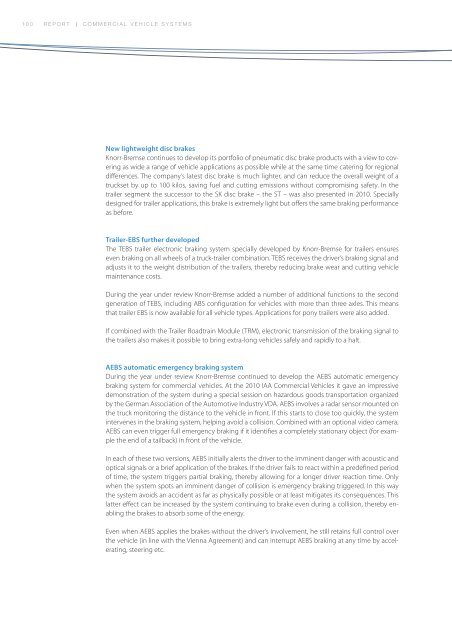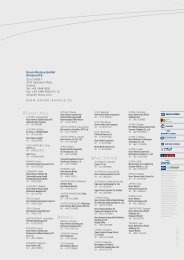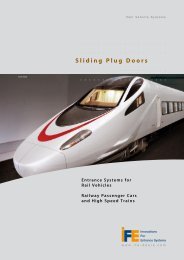Annual Report 2010 - Knorr-Bremse AG.
Annual Report 2010 - Knorr-Bremse AG.
Annual Report 2010 - Knorr-Bremse AG.
Create successful ePaper yourself
Turn your PDF publications into a flip-book with our unique Google optimized e-Paper software.
100 RepoR t | CoMMe RCIAL VeHICLe SYSteMS<br />
New lightweight disc brakes<br />
<strong>Knorr</strong>-<strong>Bremse</strong> continues to develop its portfolio of pneumatic disc brake products with a view to covering<br />
as wide a range of vehicle applications as possible while at the same time catering for regional<br />
differences. The company’s latest disc brake is much lighter, and can reduce the overall weight of a<br />
truckset by up to 100 kilos, saving fuel and cutting emissions without compromising safety. In the<br />
trailer segment the successor to the SK disc brake – the ST – was also presented in <strong>2010</strong>. Specially<br />
designed for trailer applications, this brake is extremely light but offers the same braking performance<br />
as before.<br />
Trailer-EBS further developed<br />
The TEBS trailer electronic braking system specially developed by <strong>Knorr</strong>-<strong>Bremse</strong> for trailers ensures<br />
even braking on all wheels of a truck-trailer combination. TEBS receives the driver’s braking signal and<br />
adjusts it to the weight distribution of the trailers, thereby reducing brake wear and cutting vehicle<br />
maintenance costs.<br />
During the year under review <strong>Knorr</strong>-<strong>Bremse</strong> added a number of additional functions to the second<br />
generation of TEBS, including ABS configuration for vehicles with more than three axles. This means<br />
that trailer EBS is now available for all vehicle types. Applications for pony trailers were also added.<br />
If combined with the Trailer Roadtrain Module (TRM), electronic transmission of the braking signal to<br />
the trailers also makes it possible to bring extra-long vehicles safely and rapidly to a halt.<br />
AEBS automatic emergency braking system<br />
During the year under review <strong>Knorr</strong>-<strong>Bremse</strong> continued to develop the AEBS automatic emergency<br />
braking system for commercial vehicles. At the <strong>2010</strong> IAA Commercial Vehicles it gave an impressive<br />
demonstration of the system during a special session on hazardous goods transportation organized<br />
by the German Association of the Automotive Industry VDA. AEBS involves a radar sensor mounted on<br />
the truck monitoring the distance to the vehicle in front. If this starts to close too quickly, the system<br />
intervenes in the braking system, helping avoid a collision. Combined with an optional video camera,<br />
AEBS can even trigger full emergency braking if it identifies a completely stationary object (for example<br />
the end of a tailback) in front of the vehicle.<br />
In each of these two versions, AEBS initially alerts the driver to the imminent danger with acoustic and<br />
optical signals or a brief application of the brakes. If the driver fails to react within a predefined period<br />
of time, the system triggers partial braking, thereby allowing for a longer driver reaction time. Only<br />
when the system spots an imminent danger of collision is emergency braking triggered. In this way<br />
the system avoids an accident as far as physically possible or at least mitigates its consequences. This<br />
latter effect can be increased by the system continuing to brake even during a collision, thereby enabling<br />
the brakes to absorb some of the energy.<br />
Even when AEBS applies the brakes without the driver’s involvement, he still retains full control over<br />
the vehicle (in line with the Vienna Agreement) and can interrupt AEBS braking at any time by accelerating,<br />
steering etc.








![Geschäftsbericht 2012 [PDF, 13 MB] - Zelisko](https://img.yumpu.com/22524926/1/184x260/geschaftsbericht-2012-pdf-13-mb-zelisko.jpg?quality=85)







